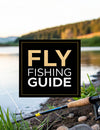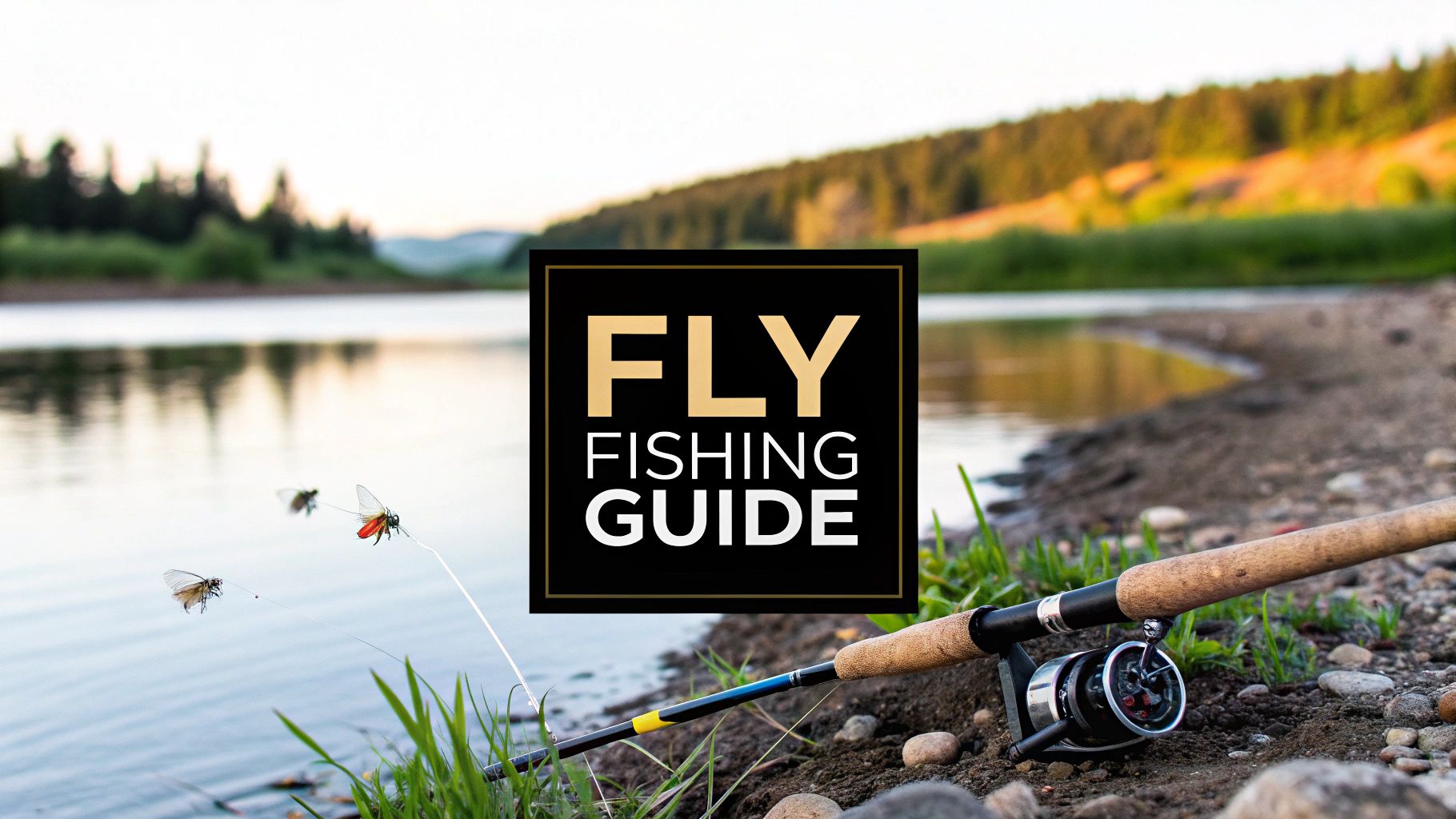
At its heart, fly fishing is all about deception. It boils down to one simple idea: choosing the right fly to imitate whatever the fish are eating at that moment. This core concept, famously known as "matching the hatch," is the foundation of every strategy you'll ever use on the water.
Your goal is to present a convincing meal, whether that means delicately landing a dry fly on a calm surface, drifting a nymph deep in the current, or stripping a streamer to mimic a panicked baitfish.
Understanding the Foundations of Fly Fishing
Think of the different fly fishing methods as a mechanic's toolbox. You wouldn't grab a hammer to loosen a bolt, right? It's the same on the river. You can't just throw a dry fly into a deep, churning run and expect results when the trout are feeding on the bottom. Each technique is a specific tool designed to solve the unique puzzle the fish and their environment present.
And while you're out there solving those puzzles, never forget about safety. A well-stocked https://letsparty-au.myshopify.com/blogs/news/wilderness-first-aid-kit isn't just a good idea; it's an essential piece of gear for any serious angler.
Fly fishing's appeal has exploded in recent years. What was once a quiet, niche pastime is now a global passion. The market, valued at $1.12 billion in 2025, is on track to hit $2.01 billion by 2035. That's a lot of new anglers discovering the pull of the sport. You can dig into the numbers in this fly fishing market report.
To help make sense of it all, here's a quick reference table breaking down the main methods we'll cover.
Quick Guide to Fly Fishing Methods
| Method | What It Imitates | Best Water Conditions |
|---|---|---|
| Dry Fly | Adult insects on the water surface | Calm to moderately moving water, visible rising fish |
| Nymphing | Immature insects, eggs, and worms drifting below the surface | Moving water of any depth, especially runs and riffles |
| Streamer | Baitfish, leeches, sculpins, and crayfish | Rivers, lakes, and streams; often effective in colored-up water |
This table is just a starting point, of course. The real art is learning when and where to apply each technique.
The Three Main Approaches
To keep things simple, almost every technique you'll learn falls into one of three buckets:
- Surface Fishing: This is the classic, visual game of imitating insects that have landed on or are emerging from the water's surface.
- Subsurface Fishing: The workhorse of fly fishing. You'll be targeting fish where they spend over 90% of their time feeding—underwater.
- Reactionary Fishing: Think big and aggressive. This involves using larger flies to mimic baitfish or leeches, triggering a fish's predatory instinct to strike.
Once you get a feel for these fundamentals, you can start exploring amazing destinations to put them into practice, like the best places to go fly fishing in the Smokies. This guide will walk you through each core method, giving you the knowledge you need to read the water, understand fish behavior, and ultimately, become a much better angler.
Mastering the Surface with Dry Fly Fishing
If you ask someone to picture fly fishing, chances are they’ll imagine this. Dry fly fishing is the classic, picture-perfect vision of the sport: an angler casting a tiny fly to a rising trout, watching and waiting for that gentle, heart-stopping sip from the surface. It’s all about the visual thrill and the chess match of a perfect presentation.
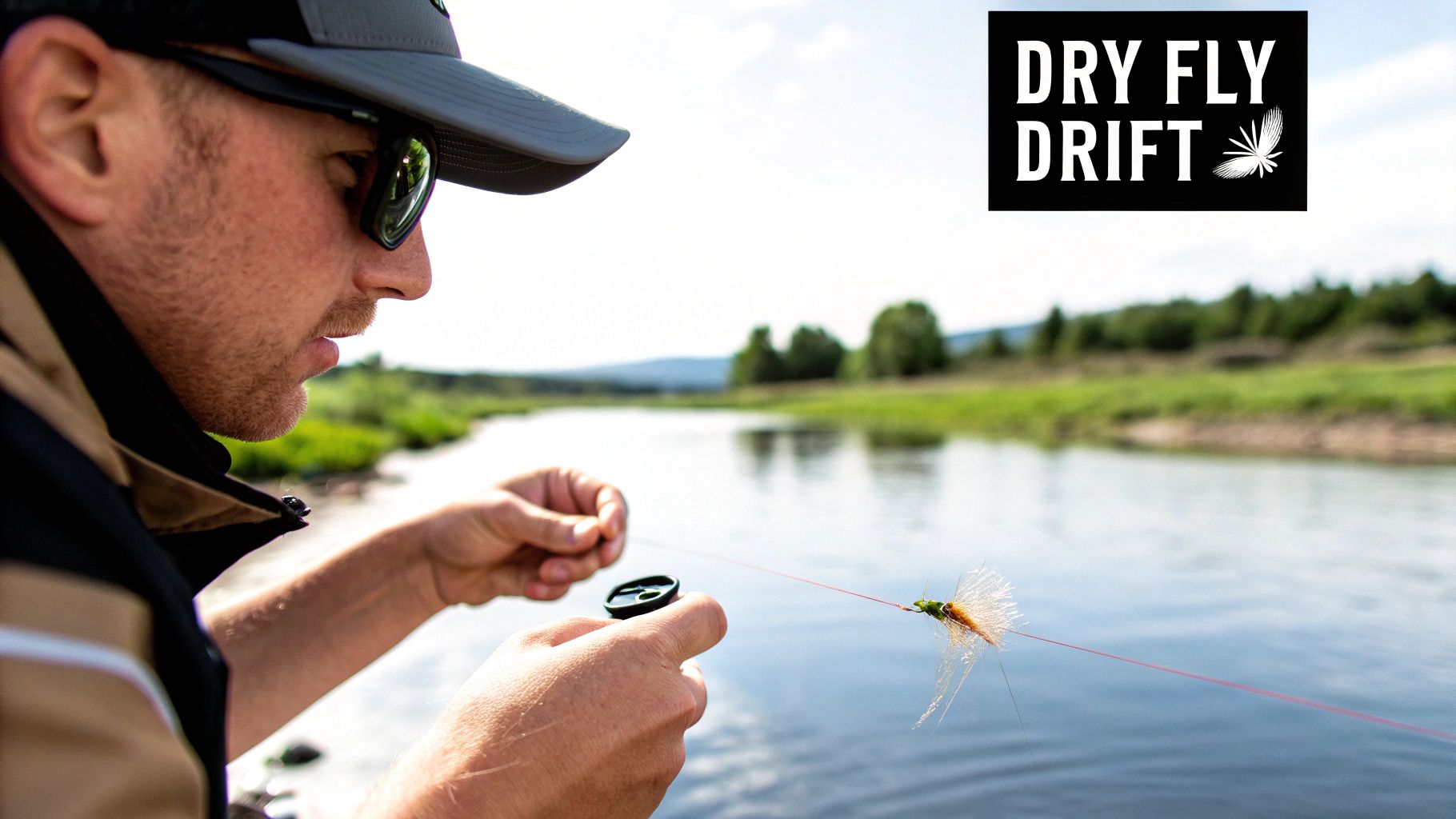
The idea is straightforward, but the execution is a true art form. You're trying to fool a fish with a buoyant fly that rides on the water's surface film. Your goal is to imitate a specific insect—maybe an adult mayfly or caddis emerging from the water, or even a terrestrial bug like an ant or grasshopper that took a wrong turn and fell in.
Reading the Water for Rises
The absolute best time to reach for a dry fly is when you see fish actively feeding on top. Those little rings on the water, known as "rises," are your invitation. It’s a dead giveaway that fish are looking up for their next meal, often during a big insect hatch when bugs are emerging all at once.
Look for these ideal conditions:
- Visible Insect Hatches: If you see clouds of insects hovering over the river, it's game on.
- Calm Water Surfaces: Slow pools, glassy slicks, and gentle runs make it much easier to spot rises and get a clean presentation.
- Clear Water Clarity: Good visibility helps you spot fish before they spot you, allowing you to watch their feeding patterns.
This iconic style of fishing is more popular than ever. The global market for dry flies was valued at an impressive $1.5 billion in 2023 and is expected to nearly double to $2.9 billion by 2031. This boom is driven by a surge in outdoor recreation and incredible advancements in synthetic materials that make modern flies tougher and more lifelike than ever. You can discover more insights about the dry fly market here.
Gear and the Perfect Drift
In dry fly fishing, everything hinges on a natural presentation. The ultimate goal is to achieve a perfect drag-free drift, which means your fly needs to float downstream at the exact same speed as the current, just like a real bug would. Any unnatural pull or "drag" from your line will give the game away.
The greatest challenge—and the greatest reward—of dry fly fishing is making the fish believe your artificial fly is a real, helpless insect drifting along with the current. Any unnatural movement, or 'drag,' will instantly spook a wary trout.
Getting that perfect drift starts with the right gear.
- Floating Fly Line: This is a must. Your line has to stay on top of the water, or it will pull your fly under.
- Long, Tapered Leader: A leader of 9 feet or longer is your friend. It creates distance between your fly and the thicker, more visible fly line, making it less likely you’ll scare the fish.
- Delicate Rod Presentation: Lighter rods, typically in the 3 to 5-weight range, are designed for the gentle, accurate casts needed to place a dry fly softly on the water without a splash.
Common Mistakes to Avoid
Even seasoned anglers can mess up a good drift. The number one mistake? Making too much noise and commotion. Crashing through the water while you wade or letting your shadow fall over the pool you're about to fish is the fastest way to send every trout running for cover.
Always approach the water with stealth. Keep a low profile, move slowly, and pay close attention to where the sun is casting your shadow. A quiet, patient approach is often what separates a great day on the water from just a day of casting practice.
Exploring the Underwater World of Nymphing
While a trout sipping a dry fly off the surface is the picture-perfect image of fly fishing, the reality is that fish eat the vast majority of their food underwater. In fact, trout get over 90% of their meals below the surface. This is where nymphing comes in, and it's arguably the most productive method you can master.
Nymphing is all about presenting flies that imitate the immature, underwater stages of aquatic insects. You’re drifting these imitations right through the currents where fish are holding and actively feeding.
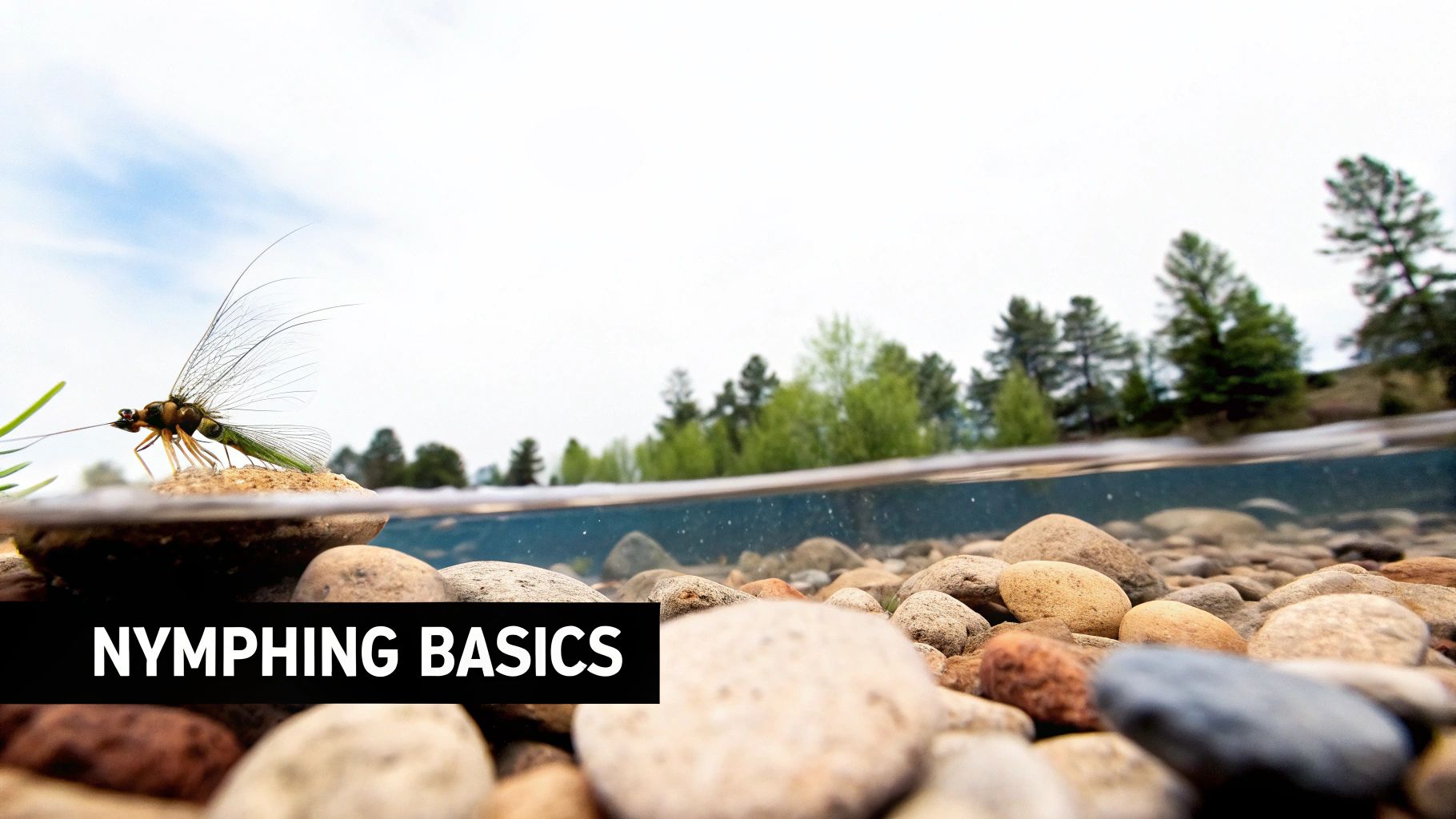
Think of it this way: dry fly fishing is like offering a single, floating appetizer. Nymphing is like delivering the entire buffet line directly to the fish. The challenge—and the art—lies not in seeing the strike, but in learning to detect it through feel and subtle visual cues.
The Indicator Rig: A Visual Approach
For anyone just getting into the nymphing game, starting with an indicator rig is the way to go. It works a lot like a bobber in traditional fishing, giving you a bright, obvious signal when a fish takes your fly. The setup is simple: a buoyant strike indicator is attached to your leader, with one or more weighted nymphs tied below it.
The secret sauce here is adjusting the indicator's position to control how deep your flies drift. Your goal is to get those nymphs ticking along just above the riverbed, right in the trout's prime feeding zone.
Indicator nymphing really shines in certain types of water:
- Deep Pools and Runs: Perfect for getting your flies down to fish holding in slower, deeper water.
- Seams and Drop-offs: An indicator helps you drift your flies perfectly along the edges where fast and slow water meet.
- Consistent Currents: This method is deadly in water with a steady flow that allows for a long, drag-free drift.
Tight-Line and Euro Nymphing: For Ultimate Sensitivity
Once you've got the hang of indicator fishing, you might want to try Euro nymphing, also known as tight-line nymphing. This advanced style ditches the indicator completely. Instead, you keep a direct, tight-line connection to your flies, using a long, sensitive rod and a thin, specialized leader to feel for the slightest tick or hesitation that signals a fish has eaten.
A brightly colored section of line called a "sighter" is built into the leader to serve as a subtle visual cue. You watch the sighter for any pause or dip as you guide your flies through the current. This technique gives you incredible sensitivity and precise depth control, making it a game-changer in fast, complex currents. It’s especially effective in choppy pocket water and riffles where a traditional indicator would get dragged around unnaturally.
Nymphing forces you to read the water on a deeper level. You're not just looking at the surface; you're visualizing the currents, structure, and feeding lanes hidden beneath, connecting with the river in a more intimate way.
Detecting the Strike and Controlling Depth
No matter which style of nymphing you choose, success boils down to two things: strike detection and depth control. Since you almost never see the fish eat, you have to become an expert at interpreting other signs. A sudden stop in your indicator, a tiny twitch in your sighter, or even just a feeling of "heaviness" on the line are all clues that a fish has your fly.
The best advice you'll ever get is: "When in doubt, set the hook." A hook set costs you nothing, but a missed fish is a lost opportunity.
To manage your depth, you'll use a combination of weighted flies and small weights called split shot. Don't be shy about making adjustments. If you aren't feeling your flies tick the bottom every so often, you're probably not deep enough. If you're constantly getting snagged, you're too deep. Finding that sweet spot is the heart of the nymphing game.
The Aggressive Art of Streamer Fishing
If dry fly fishing is like a delicate game of chess and nymphing is a patient underwater hunt, then streamer fishing is an all-out street fight. This is where subtlety goes out the window. You’re no longer imitating tiny insects; you’re chucking big, flashy patterns designed to look like baitfish, leeches, or crawdads.
The whole point isn't to trick a fish into a gentle sip. It's to provoke a violent reaction. By stripping, pausing, and jerking the fly through the water, you're tapping into a predator's most basic instinct: chase and kill. It's one of the most exciting ways to fish, turning a slow day into a heart-pounding pursuit.
How to Trigger That Predatory Strike
The magic of streamer fishing is all in the retrieve. Unlike the dead-drift you need for dry flies and nymphs, here you are the one bringing the fly to life. The way you strip that line back in determines whether your fly looks like a wounded minnow or a crawdad scrambling for cover.
There are a few classic retrieves you’ll want to master:
- The Slow and Steady: A consistent, even strip is perfect for imitating leeches or a baitfish just cruising along. This is a killer technique in colder water when fish are a bit more sluggish.
- The Erratic Jerk-Strip: This one is all about quick, sharp strips followed by a dead stop. That stop-and-go action is the universal signal for an injured, easy meal—something big predatory fish simply can't ignore.
- The Swing Down and Across: A favorite for covering water. You cast across the current, let the line tighten, and just let the fly "swing" across the river. This gives the fish a perfect broadside view of the fly, often triggering an explosive strike.
This active style of fishing demands a bit more from your gear. It’s no surprise that the market for freshwater fly fishing rods is projected to hit $850 million globally in 2025. That growth comes from anglers needing rods with enough backbone to throw heavy streamers while still being sensitive enough to feel the take. Discover more insights about freshwater fly fishing rods.
Ideal Conditions for Streamer Success
While you can throw a streamer just about any time, some conditions really let this technique shine. This is your go-to method when you’re specifically hunting for the biggest, meanest fish in the river—think trophy brown trout, bass, or pike.
Streamer fishing isn't about matching a hatch; it's about starting a fight. You're creating a disturbance, invading a predator's territory, and daring it to react. The strike is rarely subtle—it's an ambush.
Keep an eye out for these scenarios to tie on something big:
- Stained or Off-Color Water: After a good rain, when the water is murky, the larger profile and vibration of a streamer helps fish find your offering.
- Overcast Days: Low light makes big fish feel more secure, encouraging them to leave their hiding spots and actively hunt.
- High Water: When the river is up and moving fast, fish will tuck in behind logs and boulders to get out of the main current. A well-placed streamer can tempt them out of their lie.
Gearing Up for an Aggressive Take
Because you're casting heavy, wind-resistant flies and expecting a violent grab, your gear needs to be up to the job. That trusty 5-weight trout rod is probably going to struggle.
Most anglers opt for heavier 6- to 8-weight rods that have the power to launch a big fly and the strength to fight a big fish.
Your line and leader are just as critical. A sinking or sink-tip line is often a must-have for getting the fly down to where the fish are, especially in deep pools or fast water. To finish the setup, you’ll want a short, stout leader built with 10- to 20-pound test tippet. This gives you the brute strength to set the hook hard and turn a big fish when it makes a powerful run for cover.
Choosing Your Gear for Different Methods
Picking the right gear for your chosen fly fishing method isn't about owning a dozen different rods. It’s about understanding which tool is right for the job. Think of it like a carpenter—you wouldn't use a sledgehammer to drive a finishing nail. The same logic applies on the water, where your gear can make or break your day.
A delicate 3-weight rod, for instance, is absolutely perfect for the subtle, precise presentation you need to drop a dry fly gently in front of a rising trout. But if you try to heave a heavy, waterlogged streamer with that same rod, you'll just end up frustrated. It simply doesn't have the backbone for that kind of work.
Matching Rods to Methods
On the flip side, trying to fish tiny dry flies with a powerful 7-weight rod built for streamers is a recipe for disaster. That stiff rod would make it nearly impossible to protect the light tippet you're using, and you'd likely snap your line the moment a fish takes. The real secret is matching your rod's power to the fly you're casting and the technique you're using.
As you start collecting gear for different situations, keeping it all organized and, more importantly, dry becomes a real priority. Grabbing one of the best waterproof backpacks available at https://letsparty-au.myshopify.com/blogs/news/best-waterproof-backpacks is a smart move to protect your reels, fly boxes, and phone from an unexpected dunking.
This infographic gives a great visual breakdown of the kinds of big, tempting flies used in streamer fishing.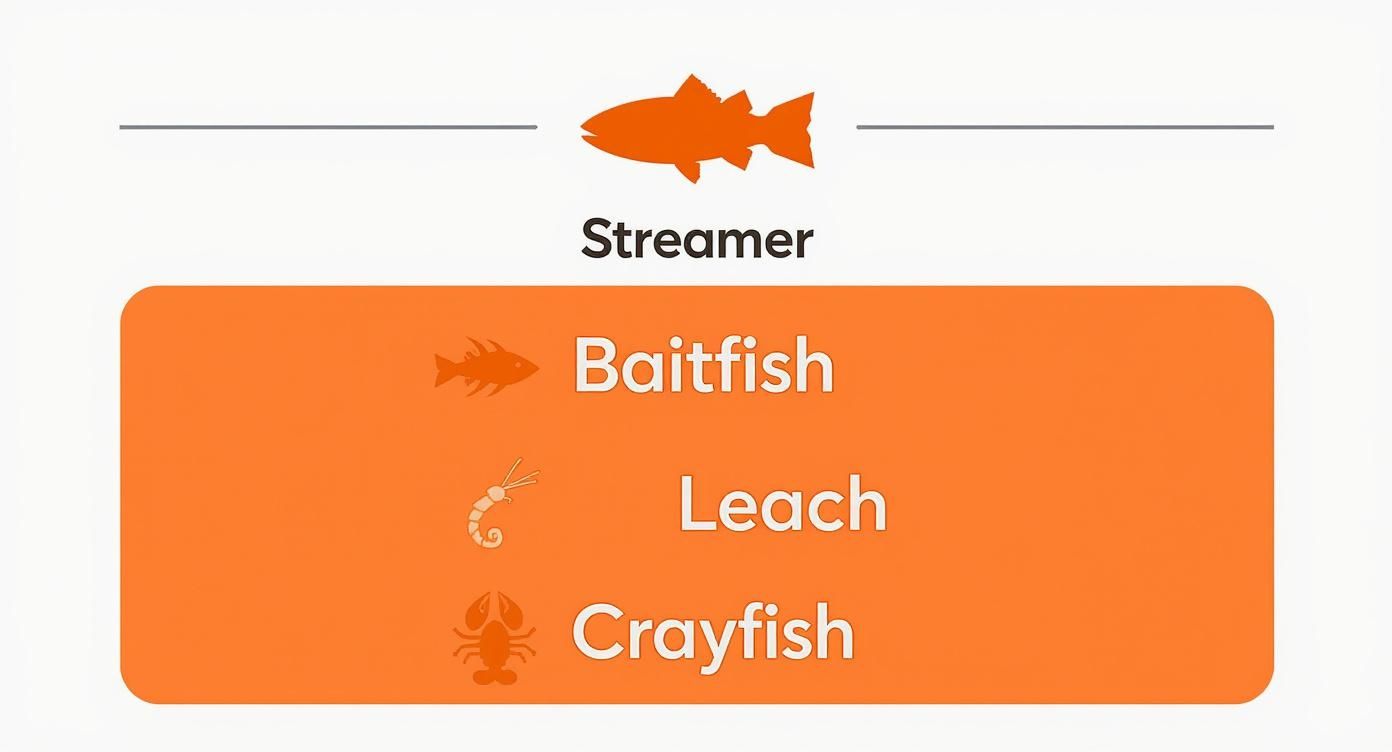
As you can see, streamers aren't meant to imitate tiny insects; they’re designed to look like a substantial meal like a minnow or a leech, triggering an aggressive, predatory strike from bigger fish.
A Quick Gear Comparison Guide
To help you get started, this table lines up the three main fly fishing methods with the gear that works best for them. Think of it as a cheat sheet for building a well-rounded setup. Of course, having the right rod is just one piece of the puzzle; you can find more guidance on Australia's best fishing gear to round out your kit.
Gear Matching Guide for Fly Fishing Methods
This table breaks down the essentials for the three primary fly fishing techniques. Use it as a starting point to make sure your rod, line, and leader are working together, not against each other.
| Method | Ideal Rod Weight | Fly Line Type | Common Leader | Example Flies |
|---|---|---|---|---|
| Dry Fly | 2-5 weight | Floating | 9-12 ft, 4x-6x tippet | Parachute Adams, Elk Hair Caddis |
| Nymphing | 4-6 weight (often 10ft+) | Floating (or specialized level line) | 7-9 ft, 3x-5x tippet | Pheasant Tail, Hare's Ear |
| Streamer | 6-8 weight | Floating, Sink-Tip, or Full Sink | 4-7 ft, 0x-3x tippet | Woolly Bugger, Clouser Minnow |
The goal here is synergy. A light rod needs a light line and a long, delicate leader for dry flies, while a heavy streamer setup requires a powerful rod and a short, stout leader to turn over those big flies.
Remember, a versatile 9-foot, 5-weight rod is often called the "all-arounder" for a reason. It can handle most dry fly, nymphing, and small streamer situations, making it the perfect first rod for new anglers.
Ultimately, knowing the "why" behind your gear choices is what turns you from someone who just casts into an angler who truly fishes with purpose and intent.
FAQ About Fly Fishing Methods
Getting into fly fishing opens up a whole new world, but it can also bring up a lot of questions. Let's tackle some of the most common ones I hear from anglers to help you get on the water with a bit more confidence.
What Is the Easiest Fly Fishing Method for a Beginner?
For most people just starting, indicator nymphing is the way to go. Think of the strike indicator as a bobber—it gives you a really clear, visual signal the second a fish eats your fly underwater.
This simple visual cue takes away the biggest hurdle for new nymphers: figuring out when you've actually got a bite. It’s also incredibly effective. Since fish eat over 90% of their food beneath the surface, you’re putting your fly right where the action is, which means you'll probably catch more fish while you're still getting the hang of casting.
How Do I Know Which Method to Use?
The best way to decide is to become a good observer. Before you even wet a line, just take a few minutes to watch the river and let it tell you what to do.
- See fish rising? If you spot splashes or soft rings on the surface, that’s your cue. Fish are actively feeding on top, so it’s time to tie on a dry fly.
- No surface activity? When the water looks calm and quiet, the fish are almost certainly feeding down below. Nymphing will be your most productive strategy to get a fly in front of them.
- Is it overcast or murky? Cloudy days, or when the water is a little off-color after a rain, can make bigger fish feel bold and aggressive. This is the perfect opportunity to switch to streamer fishing and imitate a fleeing baitfish.
The river always tells you what it wants. Your job as an angler is to listen, watch, and then present your fly in a way that joins the conversation. The best fly fishing methods are the ones that match the conditions right in front of you.
Can I Use One Rod for All Fly Fishing Methods?
Absolutely. Especially when you're starting out, one versatile rod is all you need. A 9-foot, 5-weight rod is the classic all-around choice for a reason. It’s delicate enough for most dry fly presentations but has enough power to cast nymph rigs and smaller streamers.
As you get more into it, you'll start to see why specialized gear exists. A longer 10-foot rod gives you way better line control for nymphing, while a heavier 7- or 8-weight rod is almost essential for throwing big, wind-resistant streamers all day. Having the right tool for the job always helps, and that applies to all your gear; for more on trip readiness, check out our comprehensive day hike packing list, which has great tips for anglers, too.






